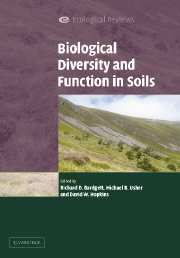Book contents
- Frontmatter
- Contents
- List of contributors
- Preface
- Acknowledgements
- PART I Introduction
- PART II The soil environment
- PART III Patterns and drivers of soil biodiversity
- PART IV Consequences of soil biodiversity
- PART V Applications of soil biodiversity
- 16 Soil biodiversity in rapidly changing tropical landscapes: scaling down and scaling up
- 17 Restoration ecology and the role of soil biodiversity
- 18 Soil biodiversity: stress and change in grasslands under restoration succession
- 19 Soil biodiversity, nature conservation and sustainability
- PART VI Conclusion
- Index
- References
18 - Soil biodiversity: stress and change in grasslands under restoration succession
Published online by Cambridge University Press: 17 September 2009
- Frontmatter
- Contents
- List of contributors
- Preface
- Acknowledgements
- PART I Introduction
- PART II The soil environment
- PART III Patterns and drivers of soil biodiversity
- PART IV Consequences of soil biodiversity
- PART V Applications of soil biodiversity
- 16 Soil biodiversity in rapidly changing tropical landscapes: scaling down and scaling up
- 17 Restoration ecology and the role of soil biodiversity
- 18 Soil biodiversity: stress and change in grasslands under restoration succession
- 19 Soil biodiversity, nature conservation and sustainability
- PART VI Conclusion
- Index
- References
Summary
SUMMARY
Comparative field research, backed up by field and laboratory experimentation, on the effects of stress on communities is necessary to increase insight into the relationships, if any, between stress, (soil) biodiversity and ecosystem functioning.
Such insight is needed as a complement to ecotoxicological research on the effects of contaminants on species populations so as to broaden the base for environmental policies and legislation.
From a synthesis of research on reversed succession of plants, nematodes and insects in the Drentse A grasslands in the northern Netherlands, we infer that knowledge of life-history strategies at various levels of taxonomic detail is an important key to understanding stress effects on natural communities.
We observe that different approaches in research of stress on communities and ecosystems are beginning to converge in taking life-history strategies into account.
Introduction
Ecosystem structure and functioning are governed by three classes of driving variables: the physical environment, resource quality and organisms (Swift et al. 1979). Stress effects on organisms may result from biotic interactions or from changes of the physical environment and resource quality. Stress can be defined to occur when the organisms within an ecosystem are chronically confronted with abiotic conditions, resource quality conditions, new species or abundance of existing species (especially herbivores, predators or parasites) near or beyond the range of their ecological amplitude (Grime et al. 1988), and when physiological adaptation to such changes is absent (Calow & Forbes 1998).
- Type
- Chapter
- Information
- Biological Diversity and Function in Soils , pp. 343 - 362Publisher: Cambridge University PressPrint publication year: 2005

